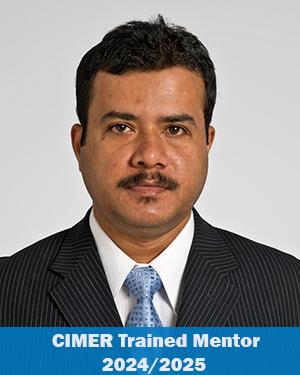Research News
01/24/2018
Critical Missing Step in Hemoglobin Maturation Process Uncovered
A protein called hsp90 (heat shock protein 90) is essential in forming functional, mature Hb that successfully delivers oxygen to cells throughout the body.

Published online January 22 in Proceedings of the National Academy of Sciences, Cleveland Clinic researchers describe for the first time how hemoglobin (Hb) forms and matures. Up until now, this process was only partially understood. Understanding how Hb is formed is critical to treating blood disorders, and research suggests may have implications for cancer treatment.
Researchers Dennis Stuehr, PhD, and Arnab Ghosh, PhD, both of Cleveland Clinic Lerner Research Institute's Department of Inflammation & Immunity, and colleagues show that a protein called hsp90 (heat shock protein 90) is critical for forming functional, mature Hb that successfully delivers oxygen to cells throughout the body.
Functional Hb is formed when heme-the iron-containing element in blood-combines with distinct globulin proteins (alpha, beta or gamma globulins). This process is facilitated by "chaperone" proteins. Previous research has shown that a chaperone protein called AHSP (alpha hemoglobin stabilizing protein) specifically binds to alpha globulins. Prior to this study, it was not known if beta and gamma globulins bind and utilize chaperone proteins.
The team discovered that hsp90 is the chaperone protein responsible for joining beta and gamma globulins with heme to form stable Hb. Both AHSP and hsp90 chaperone proteins must be present in order for Hb to mature in red blood cells and properly carry oxygen to peripheral tissues.
"We are very excited about this fundamental finding," said Dr. Stuehr. "Fully understanding how Hb is formed will allow us to better identify potential problems in blood development and opens doors to targeting a host of blood diseases, such as sickle cell disease, anemia, thalassemia and other conditions."
The discovery of hsp90's role in this process helped the team answer another long-asked research question. While Hb is typically present in red blood cells, it has also been shown to be present in some non-red blood cells, even though the chaperone protein AHSP is not. The researchers showed in a macrophage cell line and a bronchial epithelial cell line that hsp90 is the sole chaperone protein necessary to form functional Hb in such non-red blood cells.
In addition to elucidating important cellular mechanisms, these findings have relevant clinical applications. Hsp90 is known to play a role in many cancers and inflammatory diseases. Drugs that block hsp90 activity (hsp90 inhibitors) are used in some types of cancer treatment. The study authors say these therapeutics might unintentionally block Hb maturation and lead to blood-related disorders such as anemia. In fact, anemia has been reported as a side effect of hsp90 inhibitors in clinical trials.
"This study will undoubtedly have important implications for the field of clinical hematology," said Jaroslaw Maciejewski, MD, PhD, FACP, Chair, Department of Translational Hematology and Oncology Research, Taussig Cancer Institute and Lerner Research Institute. "It's critical to have a strong foundational understanding of Hb assembly and production. Thanks to these results, some of the missing steps in this process are now clarified, allowing us to conceptualize pharmacologic interventions as therapies of the future."
Dr. Ghosh is first author on the study, which was supported by awards and grants from the National Institutes of Health, Cleveland Clinic and the American Heart Association.
Featured Experts
News Category
Related News
Research areas
Want To Support Ground-Breaking Research at Cleveland Clinic?
Discover how you can help Cleveland Clinic save lives and continue to lead the transformation of healthcare.
Give to Cleveland Clinic
